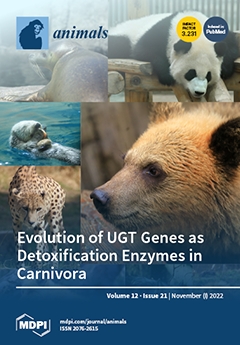Once improperly managed, the citric acid production industry generates waste, which contributes to pollution and other environmental issues. We proposed that, with sufficient quality improvement, citric acid by-product (CAP) might be used for animal feed, thereby reducing the environmental impact. The aim of the present study was to ferment citric acid by-product (CAP) by inoculation with lactic acid bacteria (LAB) and a fibrolytic enzyme mixture for quality improvement and crude fiber reduction in the waste products. LAB inoculants were
L. casei TH14, and the additive enzyme used was a fibrolytic enzyme mixture (glucanase, pectinase, and carboxymethylcellulase) of a small-scale fermentation method. The seven treatments employed in this study were as follows: (1) control (untreated), (2) CAP-inoculated
L. casei TH14 at 0.01% DM, (3) CAP-inoculated
L. casei TH14 at 0.05% DM, (4) CAP-inoculated enzymes at 0.01% DM, (5) CAP-inoculated enzymes at 0.05% DM, (6) CAP-inoculated
L. casei TH14 at 0.01% DM with enzymes at 0.01% DM, and (7) CAP-inoculated
L. casei TH14 at 0.05% DM with enzymes at 0.05% DM. The samples were taken on days 1, 7, 14, 21, and 28 of ensiling, both before and after. Four replications were used. The results of the chemical composition of the CAP before and after ensilage inoculated with
L. casei TH14 did not show any differences in crude protein, ether extract, ash, or gross energy, but the enzymes significantly (
p < 0.05) decreased crude fiber and increased nitrogen-free extract. The combination was especially effective at improving the characteristics of CAP, with a reduction in crude fiber from 21.98% to 22.69%, of neutral detergent fiber (NDF) from 16.01% to 17.54%, and of acid detergent fiber (ADF) from 13.75% to 16.19%. Furthermore, the combination of
L. casei TH14 and the enzyme increased crude protein from 1.75% to 2.24% at 28 days of ensiling. Therefore, CAP-inoculated
L. casei TH14 did not change in chemical composition, while crude fiber, NDF, and ADF decreased when CAP was inoculated with enzyme. The combination of
L. casei TH14 and the enzyme is more effective at improving chemical composition and reducing crude fiber and enhancing carbohydrate breakdown in the CAP. Finally, by enhancing the CAP’s quality, it may be possible to use it in animal feed and minimize its impact on the environment.
Full article






